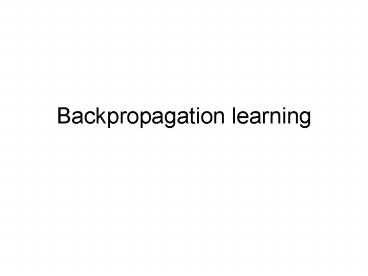Backpropagation learning PowerPoint PPT Presentation
Title: Backpropagation learning
1
Backpropagation learning
2
Simple vs. multilayer perceptron
3
Hidden layer problem
- Radical change for the supervised learning
problem. - No desired values for the hidden layer.
- The network must find its own hidden layer
activations.
4
Generalized delta rule
- Delta rule only works for the output layer.
- Backpropagation, or the generalized delta rule,
is a way of creating desired values for hidden
layers
5
Outline
- The algorithm
- Derivation as a gradient algoritihm
- Sensitivity lemma
6
Multilayer perceptron
- L layers of weights and biases
- L1 layers of neurons
7
Reward function
- Depends on activity of the output layer only.
- Maximize reward with respect to weights and
biases.
8
Example squared error
- Square of desired minus actual output, with minus
sign.
9
Forward pass
10
Sensitivity computation
- The sensitivity is also called delta.
11
Backward pass
12
Learning update
- In any order
13
Backprop is a gradient update
- Consider R as function of weights and biases.
14
Sensitivity lemma
- Sensitivity matrix outer product
- sensitivity vector
- activity vector
- The sensitivity vector is sufficient.
- Generalization of delta.
15
Coordinate transformation
16
Output layer
17
Chain rule
- composition of two functions
18
Computational complexity
- Naïve estimate
- network output order N
- each component of the gradient order N
- N components order N2
- With backprop order N
19
Biological plausibility
- Local pre- and postsynaptic variables
- Forward and backward passes use same weights
- Extra set of variables
20
Backprop for brain modeling
- Backprop may not be a plausible account of
learning in the brain. - But perhaps the networks created by it are
similar to biological neural networks. - Zipser and Andersen
- train network
- compare hidden neurons with those found in the
brain.
21
LeNet
- Weight-sharing
- Sigmoidal neurons
- Learn binary outputs
22
Machine learning revolution
- Gradient following
- or other hill-climbing methods
- Empirical error minimization
PowerShow.com is a leading presentation sharing website. It has millions of presentations already uploaded and available with 1,000s more being uploaded by its users every day. Whatever your area of interest, here you’ll be able to find and view presentations you’ll love and possibly download. And, best of all, it is completely free and easy to use.
You might even have a presentation you’d like to share with others. If so, just upload it to PowerShow.com. We’ll convert it to an HTML5 slideshow that includes all the media types you’ve already added: audio, video, music, pictures, animations and transition effects. Then you can share it with your target audience as well as PowerShow.com’s millions of monthly visitors. And, again, it’s all free.
About the Developers
PowerShow.com is brought to you by CrystalGraphics, the award-winning developer and market-leading publisher of rich-media enhancement products for presentations. Our product offerings include millions of PowerPoint templates, diagrams, animated 3D characters and more.

